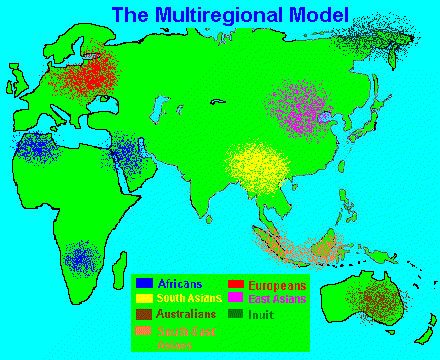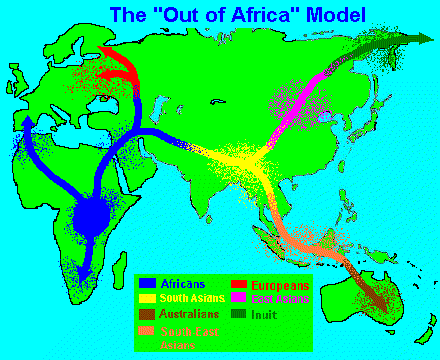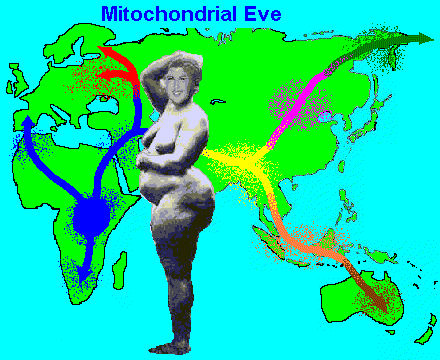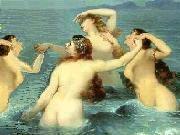Indeed, some scholars believe that modern humans evolved gradually from ancient humans in many parts
of the world. The ancient humans may have been Homo erectus, or archaic Homo sapiens, or other groups.
This proposal suggests that in each region, people gradually evolved from ancient to modern. For example,
today’s inhabitants of southeastern Asia may have evolved from Java Man,
and present-day people in the northeastern Asia region from Peking Man. Modern
Europeans came out from an intermingling of Neanderthal people and others who migrated to Europe
from elsewhere—possibly the Near East. One exception may be North and South Americas, where already-modern
people arrived within the last 50,000 years.
The following map shows the above multiregional model:

The multiregional model has many important implications. For one
thing, the scholars supporting the above model insist that the differences observed today in native
groups of peoples (in terms of physique, hair type, skin color, and so on) have a much longer evolutionary history—perhaps one million years or more.

On the contrary, the above “Out of Africa” model suggests
that a small modern human population appeared in one place and then spread, and the differences would then appear as the various
modern groups settled in new regions, presumably within the last 100,000 years
or less.
Which theory is right? So far, however, the scholars have not come
up with a conclusion because the fossil evidences support both proposals.
As described later, however, some scientists have come up with
a research result that supports the “Out of Africa” model.
The Emergence of Modern Humans
When the Cro-Magnon people entered Europe more than 30,000 years ago, they
had already evolved into anatomically modern humans. Physically, they would have been indistinguishable from
Europeans of today.
Where and when did the change occur? From which ancient man
emerged the fully modern Homo sapiens sapiens?
When did we reach the final stage in our physical evolution?
During the 1980s, evidences from paleontology, anthropology, genetics
and linguistics placed the focus of attention toward Africa.
Some of the most eyebrow-raising studies involve mitochondria—minute sausage-shaped structures inside many
kinds of living cell. Mitochondria work as energy-converter, changing basic
energy-containing substances into chemicals that the cell
can use more easily. They take an important role in human evolution because they contain one form of deoxyribonuclei acid or DNA.
DNA makes up the genes inherited by offspring from their parents. The main genes—the nucleus or “control center” of the cell—consist of nuclear DNA or nDNA. During
reproduction, nDNAs from mother and father come together, and get mixed and shuffled to give a unique gene combination
for each offspring. Sometimes the DNA changes, or mutates, and new genes appear.
You inherit mitochondrial DNA—mtDNA or mDNA—not from both parents, but only from the mother.
Because the mDNA exists in a much smaller amount compared with nDNA and has simpler mode of inheritance, it becomes a useful substance for genetic study.
The mDNA molecular clock
In the 1980s Allan Wilson, Mark Stoneking, and Rebecca Cann, from the University of California at Berkeley compared
samples of mDNA from various people who represented many regional or racial
groups. They wanted to find out how much mDNA differed among the groups. This could give some idea of the closeness of the
relationships of these groups alive today.
The more similar their mDNA, the more closely related they become.
The idea of a “molecular clock”
assumes that mutations in mDNA crop up at a known and regular rate. If this holds true, it should be possible to work back and estimate how long it took
since two samples of mDNA diverged from the common ancestor. The mDNA of humans as a group
has also been compared with our closest relatives, the chimps.
Many scholars assumed that humans and chimps last shared a common ancestor five million or more years ago.
The amount of mDNA divergence that has occurred ever since helps to “set” the molecular clock.
Mitochondrial Eve
The mitochondrial DNA studies have thrown up some remarkable conclusions. Computer-constructed
relatedness trees show the least number of mDNA mutations required to bring about the observed diversity. The fewer
mutations, the closer the relationship. A greater “genetic
distance” indicates a common ancestor further back in time.
The results showed that people from different parts of Africa have most diversity in their mDNA. This suggests
that modern humans have been living there the longest, giving enough time for these DNA changes to occur.
Further calculations came to the startling conclusion that all modern people have the same origin—a relatively small
population of humans who lived in Africa 200,000-150,000 years ago. Scholars sometimes
referred to this finding as the “African Eve” or “Mitochondrial Eve” hypothesis. All
anatomically modern people—Homo sapiens sapiens, including ourselves and groups
like the Cro-Magnons—can trace their history back to this time.

DNA tests show humans not Neanderthals’ descendants
For more than a century, scientists believed our direct ancestors to be Neanderthal man, a hulking ape-like creature who lived in Europe and the Middle East some 300,000 years ago.
But new DNA tests may have finally proven that, while we may be distantly related to the Neanderthals, they did not produce us directly.
Scientists extracted and cloned DNA from the bones of a Neanderthal specimen. The results showed that human DNA and Neanderthal DNA had too many differences to be directly related.
Instead, the results bolster the hypothesis that our ancestors, the first Homo sapiens, emigrated from Africa about 100,000 years ago and lived side-by-side with the Neanderthals.
More graceful and agile, Homo sapiens survived. But the Neanderthals, despite their abilities to make tools and weapons, couldn’t adapt themselves to the harsh and changing climate of the times and died out.
|
Homo sapiens
sapiens spread from this small and discrete origin to take over the world.
This proposal has become known as the “Out of Africa” model of modern human origins.
The analysis of the mDNA information makes certain assumptions, and both
these and the conclusions have triggered enormous debate.
For one thing, the degree
of similarity between two samples of mDNA genes can only indicate relatedness if the shared genes came from the
same ancestor, rather than appearing by chance.
For another, if populations of people become separate, undergo mDNA changes, and then mix and interbreed again, this chain of actions can alter the results. The arguments are technical, and opinions have evolved since the original scientific publications on mDNA in 1987.
Since then, however, the same type of analysis on nuclear DNA, as
well as research for the biochemicals in our nDNA codes, has supported the “Out of Africa” scenario.
|

The above diagram shows a tree of relatedness for various human biochemicals,
coded for by the DNA in the cell nucleus. The African group members are more closely
related to each other, so are those of each group. This supports the “Out of Africa” model. A new population appeared
in one area (Africa) and then spread, replacing any other human groups on the way.
|
The “Out of Africa” model of human evolution and migration resembles
those of other animals, for example, mammoth—the relative of the elephant. If you haven’t
visited this page (How Come Mammoth Went Extinct?), please do so by clicking the link.








